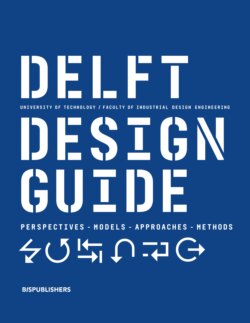Читать книгу Delft Design Guide -Revised edition - Annemiek van Boeijen - Страница 14
На сайте Литреса книга снята с продажи.
ОглавлениеYou have the completely revised and extended Delft Design Guide in your hands. This guide is meant for everyone that is - or aspires to be - a designer. It should help you to understand how a designer thinks, what a designer does and how this is done, the Delft way. The diversity of perspectives and methodologies presented in this guide shows that design is a rich field with many applications and a network of ways of working and tools to use. The Delft Design Guide offers you a set of perspectives, models, approaches, and methods that serve four distinct purposes.
A guide to the
Delft Design Guide
13
First, to help you to diverge or converge in your design project in a structured way, identifying and selecting options to solve your design challenges. Second, to help you determine what information and knowledge to find and use to allow you to make decisions and progress the design process. Third, to document and communicate a way of working that helps others to participate and collaborate with you. Finally, to develop yourself as a designer with a strong identity and rich toolbox to tackle the challenges ahead!
Build a mindset
The domains and application areas that design contributes to are becoming increasingly complex and turbulent. For example, designing interventions that help bring about positive change in the healthcare system, or that change our relationship with the climate are immensely complex and require skills, creativity and thoughtful actions, and productive collaboration. The content of this book can help you in achieving impact, yet it is not enough on its own. Much of what is needed is embedded in the culture and values of our faculty, the missions of the design challenges we collectively work on, and can be identified in the principles of our way of working. In these we can see a strong common denominator that is what makes up the Delft designer. For example, we believe in being human-centric and evidence- based. We also believe in iteration and co-creation. Methodology provides the building blocks, yet you and the people working with design need to build a design mindset to bring these together into effective and meaningful ways of working. This
is why we have added a section on mindset to each method in this new edition. These mindsets help you understand how and why a method can contribute to achieving a certain goal. Your first priority however, should always be to succeed in solving your design challenge and to have maximum impact for your cause.
Be reflective
We see design as a goal-directed discipline aimed at creating change. This is not a new idea: Nobel Laureate Herbert Simon already wrote in 1996 in his book The Sciences of the Artificial : ‘ To design is to devise courses of action aimed at changing existing situations into preferred ones ’. Design is inherently uncertain and this can be traced back to the core elements in Simon’s definition. Designers explore new and sometimes untrodden territories when they ask: what would be a preferred situation? They discover and define opportunities for innovation and improvement. They ask what would be meaningful and valuable for people in their context and dare to take a stance to steer innovation. Designers challenge the way tasks or problems are framed and formulated when they ask what is problematic about the existing situation? They will keep asking questions until they find root causes and core values that form the starting point for good design. Designers facilitate and drive the development of design solutions that can realise the preferred situation when they ask: what courses of action will best realise the preferred situation and who should I involve to make it happen? They make ideas and visions tangible
